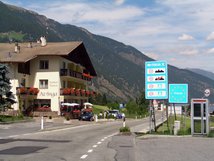Border: Italy-Switzerland
Date(s) of establishment: 1861; current demarcation in 1955Length of border: 740 km
Regions concerned: Italy – Valle d'Aosta, Piemonte, Lombardy, Trentino
Switzerland – Cantons of Valais, Ticino, Graubünden
European programme(s):
- Interreg IV A "Italy-Switzerland":
The programme on the Inforegio website
Established in 1861 with the independence of the kingdom of Italy (1861-1946), the Italo-Swiss border stretches over nearly 740 km and is divided into two sections.
The main border begins in the west, at the summit of Mont Dolent (3280 m), which also marks the beginning of the Franco-Swiss and Austro-Swiss borders. The border ends in the east, at the intersection with the Austro-Italian and Austro-Swiss borders.
The second section of the border is rather unusual, as it delimits the Italian enclave of Campione, which is located wholly within the Swiss canton of Tessin. This border lies 1 km further north than the international border and, forming a rectangle, is around 7 km long. The Italian town of Campione makes up most of the enclave of the same name. It is bordered by the eastern shore of Lake Lugano and belongs to the Italian province of Como.
History
The border between Italy and Switzerland re-uses the boundaries that existed between the numerous political entities that preceded the modern form of these two countries. In the south-west, one part of the border is the former boundary of the Republic of the Seven Zenden. In the east the boundary between the former Cisalpine and Helvetic Republics also forms part of the current border. The current southern border includes the delimitations of the common bailiwicks that the Swiss had taken from the Duchy of Milan during the Italian Wars (16th Century).
In 1866, the border was modified by the Italian annexation of the Kingdom of Lombardy–Venetia after the third Italian war of independence. The Italo-Swiss border was thus extended towards the east. In 1919, following the signing of the Treaty of Saint-Germain-en-Laye, Italy annexed Austrian South Tyrol and the Italo-Swiss border assumed its current configuration, except for one modification. Indeed, in 1955, Italy ceded 0.5 km2 of the Val di Lei region to Switzerland, so that the dam constructed in this region would be located in Switzerland.
Cross-border cooperation
This border territory is a mountainous area, sparsely populated but endowed with an exceptional natural heritage and benefiting from a location full of potential, as the lake region, because of its lower altitude, is crossed by many lines of communication. This is therefore a highly strategic location for cross-border cooperation.
Protection of the environment is one of the major priorities of the Interreg programme. The programme is intended to support projects that promote the joint protection and the joint management and optimal use of natural resources. Protection of the environment also involves supporting sustainable development, and better cohesion between urban and rural areas.
This cross-border region is rich in small and medium enterprises, but they are relatively isolated from each other because of the terrain. Bringing them closer together is therefore important, for the development of partnerships between Swiss and Italian businesses to increase their competitiveness on a European scale.
The Insubrica Working Group and the Sempione Euroregion are emblematic of this cross-border cooperation.
Territory projects and institutional bodies for cooperation
Cross-border cooperation at the regional level
Communauté de travail Alpe-AdriaArge Alp


